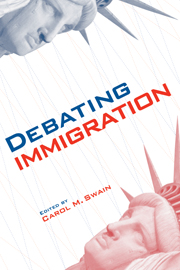Book contents
- Frontmatter
- Contents
- About the Contributors
- Preface
- Acknowledgments
- 1 Introduction
- PART I PHILOSOPHY AND RELIGION
- PART II LAW AND POLICY
- PART III ECONOMICS AND DEMOGRAPHICS
- 9 Borderline Madness
- 10 Immigrant Employment Gains and Native Losses, 2000–2004
- 11 Economics of Immigration and the Course of the Debate Since 1994
- 12 Immigration and Future Population Change in America
- PART IV RACE
- PART V COSMOPOLITANISM
- PART VI CONCLUSION
- Notes
- Index
10 - Immigrant Employment Gains and Native Losses, 2000–2004
Published online by Cambridge University Press: 05 June 2012
- Frontmatter
- Contents
- About the Contributors
- Preface
- Acknowledgments
- 1 Introduction
- PART I PHILOSOPHY AND RELIGION
- PART II LAW AND POLICY
- PART III ECONOMICS AND DEMOGRAPHICS
- 9 Borderline Madness
- 10 Immigrant Employment Gains and Native Losses, 2000–2004
- 11 Economics of Immigration and the Course of the Debate Since 1994
- 12 Immigration and Future Population Change in America
- PART IV RACE
- PART V COSMOPOLITANISM
- PART VI CONCLUSION
- Notes
- Index
Summary
Concern that immigration harms the job prospects or wages of native-born Americans has existed throughout the nation's history whenever immigration levels have been high. With more than 34 million immigrants (legal and illegal), the United States is in the midst of a great surge of immigration. Prior to the economic slowdown that began in 2000, most research that found a negative impact on natives has also found it on earnings. While the debate over earnings continues, since the economic slowdown that began in 2000, a growing body of research has raised the possibility that immigrants may also be displacing natives in the job market. This chapter will explore the relationship between immigrant and native employment between 2000 and 2004 using data collected by the United States Census Bureau over this period. Overall, there is evidence that immigration is adversely impacting the employment of native-born workers.
DATA SOURCE AND METHODS
The information for this chapter comes from the March Current Population Surveys (CPS) collected by the Census Bureau. The foreign-born or immigrant population in the CPS is estimated to include 90 percent of the illegal aliens in the country, who comprise slightly more than one-fourth of the total immigrant population. For the purposes of this chapter, foreign-born and immigrant are used synonymously. This chapter examines employment patterns among adult workers (18 years of age and older).
- Type
- Chapter
- Information
- Debating Immigration , pp. 139 - 156Publisher: Cambridge University PressPrint publication year: 2007
- 7
- Cited by



